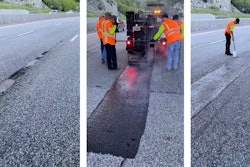Producers of liquid asphalt cement binder, emulsions and additives see performance as the driving force behind delivering longer-lasting pavements and extending the life cycle of those pavements with periodical maintenance treatments.
Polymer modified hot mix asphalt has established its place as a performance solution for Superpave mix designs. The additional rigid mat qualities that can be achieved by adding a polymer has enhanced the now standard Superpave design's ability to reduce rutting and other structural deformations to roadways exposed to high traffic volumes and heavy loads.
But the polymer modified solution is now finding its way into the maintenance and preservation side of the business. While polymer modified emulsions have been commonly used in California for the past 10 years, road agencies across the country are now specifying the additive in many of the contracts they let.
Polymer modified emulsions for slurry applications on some projects in California go back as far as 10 years ago, according to Doug Hogue, vice president for Valley Slurry Seal Macropaver.
"We're working on a lot of base materials that already have a polymer additive in them, so the agencies have specified a surface treatment that contains a polymer additive," Hogue says.
According to the Asphalt Emulsion Manufacturers Association (AEMA), polymer modified technology is used in asphalt emulsions to improve physical properties, performance and durability. Polymer asphalt emulsions provide increased service life and cost savings, allowing the use of emulsions in applications where conventional asphalt emulsions or cutback asphalts have not worked in the past. Researchers have developed new applications, such as micro-surfacing, ultrathin bonded wearing course and high performance chip seal with modified emulsions. The enhanced physical properties also improve the performance of most commonly used asphalt emulsion applications.
Polymer modified asphalt emulsions look, apply and store like conventional emulsions, but the elasticity will be evident as the emulsion is curing and throughout the life of the pavement. Polymer modified emulsions are more forgiving in tough weather and construction conditions. The paving industry is beginning to understand the value of pavement preservation and innovative applications for building, maintaining and repairing pavements.
While latex polymers used in emulsions are water-based, the performance characteristics are the same as the oil-based polymers used in hot mix designs.
"There are some definite cost benefits for the user (agency) when specifying a surface treatment with a polymer additive," Hogue notes. "It's a tougher, more durable product that's going to last longer. For contractors, it provides a clear point of difference when proposing a solution that will perform."
But the use of polymer additives is not confined to slurry seal applications. Cape seals, chip seals and other surface maintenance/preservation applications are also seeing an increase in additives to improve the performance of the road treatment, extend the life cycle of that treatment and the road it's protecting, and provide increased value to the road agencies and taxpayers.
Larry Larson, vice president of sales for SemMaterials, says the increased demand placed on highways has been the impetus behind road agencies exploring various solutions for maintaining and preserving those roads with the limited dollars they have to do so.
"They know they have to find ways to make their roads last longer, and the additives and technology available today gives them a variety of options to explore," Larson says.
As Larson notes, polymers have been the most notable of all additive solutions for maintaining and preserving roads, but other additives are also important when determining the best solution for a particular project. For example, the main criteria in treating a road surface may be completing the project as quickly as possible in order to open up the road to traffic. Additives can be used to help speed up the curing time which allows the road agency to accomplish that objective.
"There are so many variables to consider, from climate to traffic count to the availability of local materials, to the customer's experience of using different treatments to how much money is budgeted for the maintenance needs of a particular road," Larson says. "All of these factors play into the decision-making process of choosing the right solution. We (SemMaterials) constantly investigate what customers are saying is important to them in maintaining and preserving the roads they're responsible for maintaining."
But Larson and others involved in developing emulsions and other products used to maintain quality roads see the preservation side asphalt roads as a growing business, with ample opportunity for those who can deliver the right solution for the right roads at the right time.
Polymer benefits
|





















